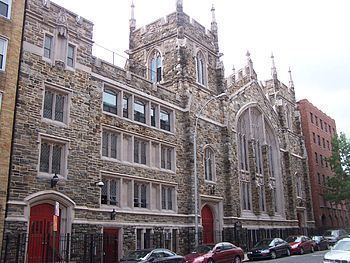Headquarters New York, United States | ||
 | ||
Similar | ||
he decided to die abyssinian baptist church
The Abyssinian Baptist Church, located at 132 West 138th Street between Adam Clayton Powell Jr. Boulevard and Lenox Avenue in the Harlem neighborhood of Manhattan, New York City, was built in 1922-23 and was designed by Charles W. Bolton & Son in Gothic Revival and Tudor Revival styles – it has also been described as "Collegiate Gothic". It features stained glass windows and marble furnishings The church is noted for its ministers, including Adam Clayton Powell, Sr. and Adam Clayton Powell, Jr. Over the years, the church has served as a place for African American spirituality, politics and community.
Contents
- he decided to die abyssinian baptist church
- The abyssinian baptist church founded in 1808 by ethiopian merchants
- History
- Music
- Today
- References
The church and its associated community house were designated a New York City Landmark on July 13, 1993.
The abyssinian baptist church founded in 1808 by ethiopian merchants
History
The congregation began after an incident in 1808, when visiting free Ethiopian seamen and allied African-American parishioners left the First Baptist Church in protest over being restricted to racially segregated seating. They named their new congregation the Abyssinian Baptist Church after the historic name of Ethiopia. Founded in 1809, it was the third oldest Baptist church in America.
The congregation worshiped at a number of places: first at 44 Anthony (Worth) Street, then in 1856, at 166 Waverly Place. In 1902 they moved uptown with the movement of the African American population, to 242 West 40th Street, and from there to a tent pitched next to Marcus Garvey's Liberty Hall in Harlem, where the size of the congregation increased dramatically thanks to the preaching of Adam Clayton Powell, Sr., who had become the pastor in 1908. The church purchased property on the same street for a new sanctuary, paid for by tithes and offerings.
By 1930, the church had 13,000 members, making it the largest African-American church in New York City, and the largest Baptist congregation in the world. Powell handed the reins of the church to his son Adam Clayton Powell, Jr. in 1937. Powell became the first black Congressman from New York City, and served 14 terms in the United States House of Representatives. Powell's "charisma, power, and notoriety", as well as his "spellbinding" preaching were the driving force behind the church's significant influence in the African American community at the time.
Civil Rights Foot Soldier Fannie Pennington was an active lifelong member.
Music
The church was an important site for religious music during the Harlem Renaissance, and remains a center of the Harlem gospel tradition. Fats Waller played the organ at Abyssinian when his father, Edward Martin Waller, was a minister at the church. Among many important events, the church conducted the wedding of Nat King Cole and his bride Maria, and the funeral of "The Father of Blues", W.C. Handy, in 1958.
Today
Adam Clayton Powell, Jr. was followed by Samuel DeWitt Proctor, and he by Calvin O. Butts. Under the direction of Butts, the church has continued to be a vital political, social, and religious institution in New York. In 1989 Butts founded the Abyssinian Development Corporation (ADC), creating a non-profit arm of the church to work on community development and social services. It has created $500 million in development, including the first new high school in Harlem in 50 years, the first large supermarket, a retail center, and housing.
In 1989, the church was one of the first to respond to Pernessa C. Seele's call for a Harlem Week of Prayer, started to mobilize the religious community in support of people with AIDS and their families. Seele has since founded Balm in Gilead, Inc., now an international non-profit providing education and prevention for HIV/AIDS, and developing other health initiatives in the United States, Africa and Caribbean.
